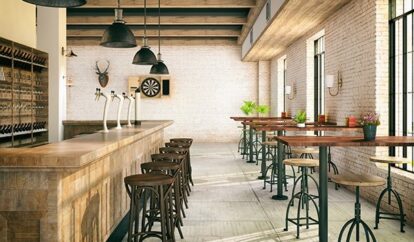So you’ve come as far as having a location in mind for your restaurant, and now you’re ready to check out the space. How do you know what to look for to determine whether it’s the right fit?
In this section we’ll tell you what to inspect with a fine-toothed comb to avoid any potential headaches. Remember the movie The Money Pit? As the title suggests, we don’t want this to happen to you.
First, rally some professionals. To properly evaluate a restaurant space with several sets of trained eyes, you’ll need access to:
- A building inspector
- An equipment technician
- A restaurant consultant (optional, but highly recommended)
When you finish reading this section, you’ll know how to assess the following elements of a restaurant location:
- Electrical, HVAC, and gas lines
- Water and sewer lines
- Utility requirements
- Accessibility
- Equipment
- Seating
- Parking
- Interior and exterior lighting
- Roof inspection
- Termite and pest inspection
- Building, fire, or safety codes violations
We know, the last thing you want to think about are HVAC systems and roof inspections when evaluating for your restaurant space requirements. But each building will have its own quirks, and you’ll appreciate knowing what to look for so you can save yourself some money, time, and stress.
Electrical, HVAC, and Gas Lines
When you first enter a space, you may be focused on the configuration of the rooms, windows and lighting, and decor – all the features of the space that will create the ambiance of your restaurant.
While you should always have your vision in mind when you’re evaluating space, some of the most important things to consider are the electrical, HVAC, and gas lines of the building. These items are some of the most costly to replace if they’re not what you need them to be, so it’s important to examine them closely.
Here’s what to consider when you’re evaluating electrical, HVAC, and gas lines.
Consideration #1: Restaurant Electrical Requirements
Come prepared with a list of all restaurant electrical requirements you’ll need for your restaurant. You’ll need this to determine whether the space can accommodate your equipment needs as is or after required renovations. With the help of a restaurant consultant, you’ll want to determine the functional needs of each room based on your restaurant equipment checklist.
What you’re looking for is a space with adequate power sources in each room. You’ll need to know that the electrical system of your building can support your equipment; if it can’t, you’ll need to factor in additional renovation expenses for electrical rewiring. If the power sources are too old or can’t support the functional needs of each room, you may want to evaluate other locations unless you are fine with added expenses.
Consideration #2: Restaurant HVAC Requirements
With the help of a professional, you can determine the condition of the HVAC system and your restaurant HVAC requirements.
Some things to inspect are:
- Inspect the filters and belts for dirt and dust to ensure clean air
- Inspect coils for dust and particles that may impair the equipment
- Check ductwork for infestations, clogs, and dirt that could lead to mold, and inspect the ducts for problems (e.g., peeling duct tape, dirt streaks, dents in the metal, collapsed or torn sections of the flex ducts)
- Check thermostats throughout your space by removing the cover and inspecting for dust, dirt, and other anomalies
- Calibrate the thermostat to determine that it’s functioning properly (check that the temperature reflects the setting)
- Inspect the wiring to make sure everything is properly connected and that the heating and air are properly functioning
We will keep this short and blunt: an old or damaged HVAC system can cost you upwards of tens of thousands of dollars. Prevention is easy.
Consideration #3: Restaurant Gas Line Installation
Determining whether there is a gas line will help you establish a realistic renovation budget. In bigger, more bureaucratic cities like New York, connecting gas can take many months (which may be a reason to consider electrical over gas appliances).
If there is a gas appliance in the unit already, then you know there is a gas line and can add more lines to each appliance (with the help of a plumber or other professional). Be sure to inspect each gas line for leaks. Signs of a gas leak include the smell of gas, visibly damaged pipes, and the sound of a hiss as the gas escapes the pipes.
Water Lines and Sewer Lines
Water lines and sewer lines are often grouped together during inspections. As with electrical, HVAC, and gas lines, water and sewer line issues are some of the most costly problems a restaurant can face. Hire a building inspector or plumber to evaluate the condition of your water and sewer lines before buying or leasing a building.
Here’s what to pay close attention to when inspecting water and sewer lines.
Consideration #1: Know the condition of your water and sewer lines.
Hire an inspector to evaluate the building’s water and sewer lines, inspecting for these issues:
- Cracks or damages in the foundation (leading to water and sewer line damage in the future)
- Deteriorated cast-iron sewer lines
- Water pipe damages
- Fresh water leaks
- Broken copper pipes and pinhole leaks
In some cities, water and sewage are grouped into a single utility service, and you’ll need to register with the local municipality and pay a monthly fee.
If the building is in an area without a local sewer system or you prefer to manage waste from your building on site, you will need to install a septic tank. You’ll need to hire a contractor to install it and connect it to your drainage system.
As with all properties, the water and sewer lines that sit on your property are your responsibility up until it reaches public property and the public utility connection – then it’s your municipality’s or county’s responsibility.
Consideration #2: Evaluate the plumbing.
A plumber or building inspector should inspect the water lines and investigate the equipment and fixtures (sinks, toilets, etc.) to determine their cost efficiency and environmental impact. You’ll need to make sure any existing fixtures and equipment are correctly installed to prevent leaks, clogs, and nasty surprises.
Plumbing may be something we take for granted, but if you talk to any business owner, they’ll tell you that any plumbing problem is typically a big plumbing problem. So you really don’t want to skimp on this part of your building assessment.
Consideration #3: Know your water type.
You’ll need to know whether you’ll be operating with hard water or soft water.
Hard water will affect your plumbing choices because calcium and other minerals damage equipment, affect the taste of beverages, and decrease the washing ability of dishwashing detergents.
The consequences of hard water can lead to energy inefficiency and increase maintenance costs. Buildings with hard water cause an increased use of chemicals and detergents to create the results you would achieve from soft water (which means more chemicals ending up in the sewage system and worse environmental impacts).
If the building has hard water, see about getting a water softener or water conditioning system. This could save you 25% on equipment replacements, 30% in energy expenses, and 35% in detergent costs.
Do a proper water analysis to determine the type of water you are working with, and from there you can determine which kind of water system is needed to deal with any future problems.
Utility Requirements
All commercial businesses typically need running water, sewage, trash removal services, telecommunications, gas, and electricity.
To get an accurate estimate on how much your restaurant will spend on utilities, you’ll need to know the approximate square footage of your space. Restaurants in the U.S. spend an average of $2.90 per square foot per year on electricity, and $0.85 per square foot/year on natural gas.
Your water, heating, and electricity bills, however, will also depend largely on where you’re located in the country. If you’re located in a hot or cold climate, you’ll spend more on cooling or heating costs compared to a restaurant located in a more temperate climate.
Take the time to evaluate the space and current appliances (if there are any), and choose your utility needs wisely for your restaurant space requirements. Saving money can also make your restaurant environmentally friendly. Sounds like a win-win.
Things to look for to save on utility costs:
- Occupancy sensors in walk-in coolers and storage areas that turn off or turn down equipment automatically (every 1,000 kWt you save is about $100 off your utility bill).
- Low-flow toilets and faucets (saving you 20-40% on water usage)
- Energy efficient appliances
- Energy efficient fluorescent light bulbs (saving you $22 per bulb per year)
Accessibility
As a business owner and employer, you’ll need to be aware of accessibility regulations in your neighborhood.
Restaurants in the U.S. need to comply with the Americans with Disability Act (ADA). Restaurants in Ontario, Canada will need to comply with the Accessibility for Ontarians with Disabilities Act (AODA).
Accessibility laws ensure physical barriers are removed to provide accessible accommodations for the elderly and people with disabilities. All counties, states, provinces, and countries tend to have their own rules and regulations for how to comply with standards.
When you’re evaluating restaurant space for accessibility:
- Look for ramps instead of stairs
- Assess stairwell encroachments
- Ensure restrooms and doorways are accessible for people who are in wheelchairs
Non-compliance will result in alienating a growing market segment and possibly backlash from your local community. As a business owner, you also have an ethical obligation to create an inclusive space that everyone can access, no matter their ability level.
North America-wide: Toronto’s StopGap Foundation is a non-profit organization that provides ramps to older buildings that are not accessible. To date, they’ve created ramps for thousands of businesses across North America.
Restaurant Equipment Inspection
Finding a space with a kitchen is a major win, but you’ll need to conduct a restaurant equipment inspection left behind with the help of an equipment technician. You’ll need to go into the space evaluation with an idea of what you need, allowing you to then evaluate what old equipment may be re-used.
Keep in mind that the cost of a major renovation for a bar and kitchen is upwards of $75,000 for a 1,000-square-foot space. Burners and espresso machines make up the largest portion of equipment costs.
Here’s what you’ll want to inspect if it’s present in the space you’re evaluating:
- Gas ranges: evaluate the state of the appliance and how many BTUs
- Ovens: gas ovens tend to be better second-hand than electrical, as electrical ovens tend to have problems with the sensors and temperature controls
- Fryers: the technician should inspect the thermostat and check that the temperature control is correct
- Grills: gas grills tend to be better than other varieties, and the inspector should check the inside and outside for warping
For any and all equipment you should ask about warranties and cleaning and maintenance regimens. Make a list of what to keep, what to fix, and what to replace to determine your required equipment budget.
Seating Potential
You’ll definitely want the support of restaurant consultant when you’re evaluating seating space, as this is directly tied to your revenue (how many people you can serve).
We’ve all been to one of those restaurants where they crammed in as many seats together as possible, and it just wasn’t worth the claustrophobia. Think about it: the layout of your restaurant will significantly impact the flow of service from kitchen to customer. You’ll need to maximize the ability of your staff to navigate the room during busy times. A hiccup in service delivery could lead to lost revenue.
You’ll want to evaluate your layout with an expert, so that you can design an ideal space that maximizes seats and minimizes barriers to service flow, all with the intention of increased revenue.
Parking
Evaluate parking availability in your neighborhood by driving around or using Google Maps to scan the surrounding area.
Suppliers, staff, and guests will need a place to park. Sure, many major cities have public transit, and it’s a major perk to find a space near a transit station. But failing to consider parking availability may result in introducing access barriers to guests willing to commute across town to your restaurant.
Keep in mind that a dedicated parking lot is helpful, but not necessary. Look for nearby parking lots, street parking, and paid parking. Also consult the local Business Improvement Association to determine whether local residents have issues with out-of-neighborhood communities parking on their residential streets. Some neighborhoods have strict parking regulations where only residential cars have permits to park on certain streets at certain times.
Restaurant Lighting Requirements: Interior and Exterior
Did you know there is published research on the impacts of lighting on a guest’s dining experience? While it may take a psychologist to understand the biochemical reactions of light on mood, we already know that lighting creates atmosphere, atmosphere creates mood, and mood determines how your guest will feel about your restaurant – and how likely they are to come back in the future.
Restaurant lighting requirements will also determine your renovation bills. The closer the current space is to your desired exterior and interior lighting (including front and back of house) the better it is on budget. The cost of labor and installation alone for your electrical remodel can be up to $35,000 for a 2,000-square-foot restaurant, not including the cost of lighting fixtures themselves.
More likely than not, you’ll have to do at least some minor remodeling to make your space’s lighting fit your desired restaurant space requirements.
Roof Inspection
With your building inspector, evaluate the condition of the roof. Find out the last time the roof was repaired, if there are warranties from the previous repair, and any potential upcoming roofing needs.
If you plan to lease, structural repairs like foundation, walls, roofs, and floor structures are typically the responsibility of the landlord. If any damages occur due to a leaky roof, it’s usually the landlord’s responsibility to replace it and pay for any damages. Even so, evaluating the roof may prevent damages from occurring, so take the opportunity to assess the condition of the roof even though you may not be directly responsible for its upkeep.
If you’re buying, keep in mind that the typical cost of replacing a commercial roof is $30,000 – and depending on the location, you may even need to acquire a permit to fix it.
Termite and Pest Inspection
To the untrained eye, termites and pests are often not easy to identify; however, you can do some of your own investigation for signs of a potential infestation.
Some signs of an infestation include:
- Pest droppings: learn the different types of droppings to know which critter left them
- Nesting: rats and mice tend to make nests with whatever they can find; look behind kitchen appliances and inside cupboards for shredded paper
- Termite holes: look for visible holes and sagging floors, and listen for hollow sounding wood; you may also notice shed wings or fecal pellets that look like sawdust
- Odd smells and sounds: most pests have a distinct smell that you may notice in the space; listen out for scurrying, gnawing, and scratching behind walls and beneath floors
Hire a building inspector or exterminator to properly investigate the building for termites and other pests. If termites are present, determine how much major structural damage has been done to the property.
Whether you’re leasing or buying a space, termites or other pest infestations will stop you in your tracks before you can even open. While there are many ways to get rid of termites and pests by yourself, you’ll want to bring in an exterminator for moderate to severe infestations.
Building, Fire, and Safety Code Violations
You’ll need to investigate building, fire, and safety codes that are relevant to your restaurant. We highly recommend leaning on the expertise of your restaurant consultant and building inspector, on top of knowing the rules and regulations yourself.
While there are no hard and fast rules that all restaurants in North America must follow, there are some general items you’ll want to check to make sure your building isn’t violating any regulations:
- Number of restrooms
- Grease trap/interceptor in the kitchen
- Type of exhaust hood
- Number of exits based on total capacity
- Fire sprinkler system
- Walk-in cooler permits
- Minimum number of plumbing fixtures
Here are some important websites to refer to, depending on where your restaurant is located.
United States
- Occupational Health and Safety Administration (OSHA)
- Guidelines and Standards (Americans with Disabilities Act)
Chicago
- Illinois Department of Labor
- Building Codes and Regulations (Illinois Capital Development Board)
New York City
Canada
- Canadian Centre for Occupational Health and Safety
- Workplace Health and Safety (Government of Canada)
Toronto
- Employment Standards and Health and Safety regulations (Ontario Ministry of Labour)
- Ontario Building Code (Ontario Ministry of Municipal Affairs and Housing)
- Accessibility rules for businesses and non-profits
Conclusion
Remember that your restaurant space requirements aren’t just a reflection of your vision; it’s a way to strategically reduce expenses and increase your customer base. As many communities seek out physically accessible and environmentally friendly restaurants, reducing barriers to access is something your business will depend on.
The best part is that accessibility, diligent inspections, and thoughtful space evaluation will save you money in the long run.





